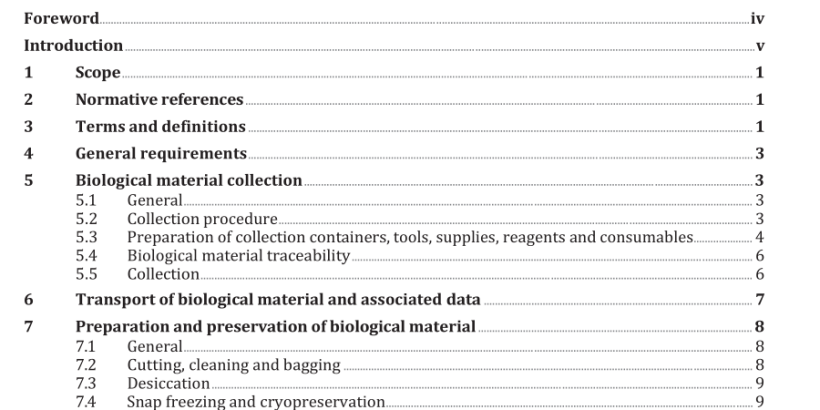ISO/TS 23105:2021 pdf download – Biotechnology — Biobanking — Requirements for the biobanking of plant biological material for research and development.
4 General requirements The biobank shall follow ISO 20387:2018, Clauses 4 to 7. The biobank shall establish, implement and maintain a quality management system in accordance with ISO 20387:2018, Clause 8. The biobank shall identify each biological material and associated data relevant to the application of this document. The biobank shall have procedures addressing biobanking for each type of biological material (e.g. whole plant, seeds, tuber, bulbs, scion wood, leaf, root, DNA, RNA) and associated data. This includes processes such as collection, acquisition, reception, characterization/evaluation, storage, preparation, preservation, rejuvenation and distribution. The biobank shall ensure the legitimate acquisition of biological material and its associated data, and the retention of any relevant documentation. If legitimate acquisition cannot be demonstrated, the biological material shall be discarded, according to documented procedures, and this shall be documented. NOTE 1 Such documentation can relate to relevant documents such as international treaties and agreements, and a phytosanitary certificate or passport. NOTE 2 Legitimate acquisition can refer to relevant regulation, permits or authorization. The biobank shall ensure that biorisk management procedures (e.g. ISO 35001, WHO guidance ) for potential plant pests and pathogens are established, documented, implemented and maintained, as appropriate. The biobank shall take measures to prevent cross contamination. The biobank or the legal entity of which it is a part shall ensure that human health and safety requirements are established, documented, implemented and maintained. The level of safety training required shall be determined using a comprehensive risk assessment of the biological and chemical materials, processes and equipment that is handled (see ISO 20387:2018, 6.2.1.5).
5.2.2 The collection procedure shall address requirements for authentication, minimum quantity, viability, stability and maintenance to satisfy the fitness for purpose, where known. The collection procedure shall also address the following aspects, including but not limited to: a) biological material type; b) fitness for purpose, where known; c) total number and amount comprising each biological material per collection; d) containers that are fit for purpose (e.g. closure integrity, composition); e) f) equipment; collection method; g) quality criteria for each biological material (e.g. the quantity and quality of targeted analytes such as DNA, RNA or protein); h) collection location(s) (e.g. by GPS), schedule, personnel and assignment; i) stage of maturity of the biological material.
5.4 Biological material traceability The biobank shall follow ISO 20387:2018, 7.5, 7.7.2, 7.7.4 and 7.10. The label or tag shall not inhibit fitness of purpose of the biological material and associated data for the intended purpose, where known. A system (e.g. double tag, mapping of storage) shall be applied to prevent the loss of biological material identity. The label or tag can also be tied to the biological material or pasted on the container. Containers shall be appropriately labelled or tagged to prevent the tag from fading or falling off so that identification is maintained throughout the life cycle of the biological material.
5.5 Collection Information defined as relevant to the collection procedure shall be documented in a traceable manner. Multiple individuals from the same population should be collected to meet the minimum number and amount requirements detailed in the collection procedure. Biological material should be collected without visible parasitic or microbial contaminants unless these are the target material. If necessary, a treatment prior to conservation or use or both shall be applied. Individual biological material should be collected in separate containers.
The biobank should refer to ISO 16106:2018, Annex A, if packaging dangerous biological material. The biobank shall request and verify certification documents before transportation, including related information (e.g. “Sample Transfer Form”, “Material Transfer Agreement ”, “Sample Information Sheet ”), transport-related documents (e.g. “Delivery Waybill”), and required permits or certifications by origin or destination country, and phytosanitary passport. Prior to transport of rare biological material, the biobank should perform risk assessment, appropriately mitigate and use suitable solutions as deemed necessary. For example, the biobank can simulate the conditions of transport prior to biological material transport to identify potential risks. The biobank should define and document specified conditions (e.g. temperature, humidity) during transportation. For fluid-preserved biological material, unbreakable, leak-proof and ethanol-resistant plastic vials should be used to avoid evaporation or spillage. Sealing the vials inside thick, ethanol-resistant plastic sleeves is advised as a further precaution.
